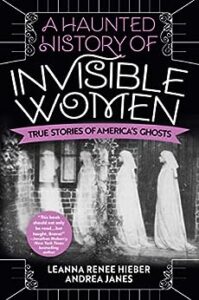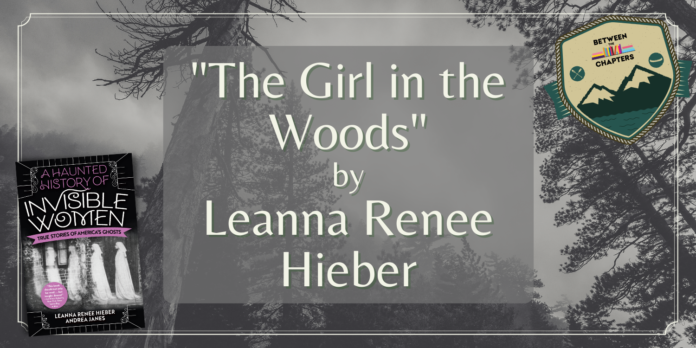Since I write, discuss, guide and research ghost stories for a living, it’s only fitting that I tell you a deeply personal, real-life, good-old-fashioned summer-camp ghost story. Ghost stories and summer camp go hand in hand and in my case, moments like this ended up shaping my career trajectory. I’ve said in many interviews and essays that some of my earliest memories are of delightedly terrifying my girl scout troupe with spooky stories I invented. Here’s one of them.
I grew up in rural Ohio. Our Girl Scout troop summer camp options were remote locations. I was about 8 or 9 years old when our troop joined other locals for a weekend overnight camp, held in a historic building that was completely surrounded by dense woods.
In retrospect, I’m not sure it was a good idea to take a load of over-imaginative children deep into the isolated woods in a historic building and give them an amorphous talent show assignment with absolutely no guardrails. But there we were, little groups separated out into pockets around this strange, old complex. I ran downstairs to claim the wood-paneled basement stage (once used as a chapel, as evidenced by an altar platform, podium and wooden cross) as our rehearsal space.
I immediately felt moved to take charge among my scout colleagues and I announced that we’d be telling a story about The Girl in the Woods.
Who was the girl in the woods, my camp-mates asked? Well…I began to speak with authority even though I was making it up as I went along.
I stared out into the deep, green woods beyond and told them all about a young woman who lived long ago, a darling girl who pined after her childhood sweetheart. Her beau had gone off to fight in some battle that she didn’t understand. But he promised he’d come back for her; to their little village in the middle of the deep green woods. She would walk in the woods every day, to their special clearing deep in the forest, and pray for his safe return. Days of walking to wait for him turned into weeks, into months, into years and finally the girl was no longer so young and whatever battle he had been engaged in surely had ended. A battle from which he never returned. Broken-hearted and unable to hold out hope any longer, one day she wandered out into the woods and just kept walking, walking, walking and simply never stopped. After her body failed her spirit kept walking… If you’re quiet… you can hear the faintest of footsteps snap the lightest of twigs. If you look closely, you can see her gaunt face peeking out from behind a tree, waiting to see if you’re her lost love finally come home…
My colleagues stared at me, then out the too-wide windows alternately. We swore we saw a figure out in those woods staring back at us. We all screamed, me included, having gotten caught up in my own story. We rushed up the stairs into an upper foyer lined in sickly green walls and awash with buzzing, garish fluorescent light.
That night, our lined-up sets of metal bunk-beds trembled from all of us working ourselves up into a frenzy. Every shadow held a figure, every footstep was hers, every window held her face.
I’d created a monster. But I was committed to her. My comrades agreed we had to tell her story. She would follow us forever if we didn’t.
For the talent show, we gathered at least thirty-some young girls into that wood-paneled basement space as dusk fell. As the lights were raised on the small stage, one of our group began telling the terrible story of The Girl in the Woods. And I, having donned a white shift and a draping fabric, having stolen someone’s purple lipstick to limn my eyes with greasy, terrible bruises, quietly began walking in from the back of the room. I edged along the audience until one girl turned to me and screamed, then the next, then the next as I kept walking slowly forward. Everyone was screaming as I took the stage and I put a finger to my lips and hushed them. The audience obeyed, looking alternately, terrified, between the now-dark woods beyond those too-wide windows, and me, standing on the stage before a worn wooden cross. As the Girl in the Woods herself, I told them I wanted them all to see me. To know that I was real. That I had lived, and loved, and died and was still in these woods. To respect the woods. To respect me. To remember that all girls had stories to tell, if we just listened. But that some of those stories might come out as screams.
There was wild (albeit nervous) applause when I took a bow. The troop leaders had no idea what to do with me. They rushed another group up to sing some cute songs afterwards, a necessary palate-cleanser for anyone hoping to sleep that night.
It was all quite ridiculous and I was terribly over-the-top. But something about that girl I’d made up haunted me. I realized that there was power in the Girl in the Woods once she became a ghost. Her ghost was no longer broken-hearted and hollow but vibrant, a force of nature staring out from blackened eyes, a figure who regained a voice and an unmistakable persistence.
I was no longer scared of her once I’d thought of what it was like to be her.
This concept of relating to a powerless figure who, in legend and whispered tales, becomes something lasting and undeniable, became part of the bedrock of A Haunted History of Invisible Women. My co-author Andrea Janes, founder of Boroughs of the Dead, writes insightfully about the staying power of the ghost herself. While my story was invented (and while we do discuss frauds and fakes), our book focuses on true stories and real histories of women who actually lived and whose spirits have become a part of local and national ghost-lore. We aim, as I did even as a child, to celebrate ghost lore as making the past contemporaneous in a present haunting.
Interestingly enough, while I made up the Girl in the Woods, I may not have made up the setting or circumstance. Only later in life did I find out the building used by the camp had once been 19th century hospital and purportedly some Union soldiers were taken or treated there during the Civil War. Many sweethearts who never went home. So, perhaps my dramatic little self was, in fact, tapping into something. An echo of that era had found its way to me. When I found out so many years later that I’d inadvertently mirrored an era and circumstance of war, I shuddered.
Another through-line from this story directly to the heart of A Haunted History of Invisible Women is that I wanted the campers to see and reckon with a woman ghost. I wanted her to be noticed, feared, empathized with but most of all: remembered. This woman I created was broken-hearted and lost to the world but I wanted to bring her forth in resilient terror.
I’d like to note for the record that I don’t believe ghost stories are or should be inherently scary. I’m far more drawn to the ghosts that want to tell us something about their deaths and in doing so illuminate our lives; be it to offer warning, perhaps a demand to be recognized, or a reminder that we’d best take care of ourselves.
But, I’ll admit, from my own varied paranormal encounters through the years, that a figure appearing from nowhere, a sound that can’t be traced or a touch when no hand is visible remains unsettling, no matter that ghosts are a part of my profession. I respect them but I’m not inured to them. As the psychic medium heroine of my Spectral City series says; ghosts are still ‘creatures of startle and shock’. They all have stories to tell, and as metaphors they are rife with possibility, but in the end, they were once people. And that is what makes them so captivating and so timeless; their ultimate closeness to us.
Walking right behind you.
Here’s a look at Leanne’s latest release:
 From the notorious Lizzie Borden to the innumerable, haunted rooms of Sarah Winchester’s mysterious mansion this offbeat, insightful, first-ever book of its kind from the brilliant guides behind “Boroughs of the Dead,” featured on NPR.org, The New York Times, and Jezebel, explores the history behind America’s female ghosts, the stereotypes, myths, and paranormal tales that swirl around them, what their stories reveal about us—and why they haunt us . . .
From the notorious Lizzie Borden to the innumerable, haunted rooms of Sarah Winchester’s mysterious mansion this offbeat, insightful, first-ever book of its kind from the brilliant guides behind “Boroughs of the Dead,” featured on NPR.org, The New York Times, and Jezebel, explores the history behind America’s female ghosts, the stereotypes, myths, and paranormal tales that swirl around them, what their stories reveal about us—and why they haunt us . . .
Sorrowful widows, vengeful jezebels, innocent maidens, wronged lovers, former slaves, even the occasional axe-murderess—America’s female ghosts differ widely in background, class, and circumstance. Yet one thing unites them: their ability to instill fascination and fear, long after their deaths. Here are the full stories behind some of the best-known among them, as well as the lesser-known—though no less powerful . . .
Tales whispered in darkness often divulge more about the teller than the subject. America’s most famous female ghosts, from ‘Mrs. Spencer’ who haunted Joan Rivers’ New York apartment to Bridget Bishop, the first person executed during the Salem witchcraft trials, mirror each era’s fears and prejudices. Yet through urban legends and campfire stories, even ghosts like the nameless hard-working women lost in the infamous Triangle Shirtwaist Factory fire —achieve a measure of power and agency in death, in ways unavailable to them as living women.
Riveting for skeptics and believers alike, with humor, curiosity, and expertise, A Haunted History of Invisible Women offers a unique lens on the significant role these ghostly legends play both within the spook-seeking corners of our minds and in the consciousness of a nation.
Reprinted with permission from Kensington Books.






